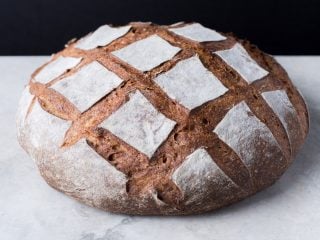Description
A large loaf with a complex and lingering flavor. This miche is perfect for large gatherings or as a single bread to sustain a family for an entire week.
Ingredients
Levain
- 59g Type 85 flour
- 29g Water
- 29g Ripe sourdough starter, 100% hydration
Autolyse
- 334g Type 85 flour
- 236g Whole grain einkorn flour, freshly milled
- 157g High-protein bread flour
- 599g water
- 1g diastatic malt powder
Main dough
- 94g Water
- 17g Fine sea salt
- 117g Ripe levain
Instructions
- Levain (9:00 a.m.)
In a small bowl or jar, mix the Levain ingredients. Cover the jar and keep it at a warm temperature for 5 hours. - Autolyse (1:00 p.m)
In a mixing bowl, add the autolyse ingredients until no dry bits remain. Cover the bowl and let rest for 1-hour. - Mix (2:00 p.m.)
Add the about half the water 2, salt, and levain to the top of the dough that was just in autolyse. With wet hands, mix thoroughly. Next, knead the dough for a few minutes (I used the slap and fold technique) until elastic and slightly smooth. If it feels like the dough can handle it, add the remaining water 2. Mix by pinching and folding until the ingredients are thoroughly incorporated and the dough is cohesive. Transfer the dough back to the bowl or to a container for bulk fermentation and cover. - Bulk Fermentation (2:30 p.m. to 5:30 p.m.)
This dough will require 3 sets of stretches and folds during bulk fermentation. After the first 30 minutes, wet your hands, grab the side of the dough farthest from you, and stretch it over to the other side. Rotate the bowl 180 degrees and repeat. Then rotate the bowl a quarter turn and stretch and fold that side. Rotate the bowl 180 degrees again and finish with a stretch and fold on the last side. The dough should be neatly folded up in the bowl. Cover and repeat these folds every 30 minutes for a total of 3 sets of stretches and folds. Then let the dough rest, covered, for the remainder of bulk fermentation. - Preshape (5:30 p.m.)
Fill a small bowl with water and place it next to your work surface. Scrape the dough onto a clean counter. With your free hand wet and bench knife in the other, preshape the single piece of dough into a loose round. - Shape (6:00 p.m.)
Lightly flour the top of your preshaped round and using floured hands, shape the dough into an round (boule) shape, then place the dough in its proofing basket, seam side up. - Proof (6:30 p.m. to 9:00 a.m. the next day)
Cover the proofing basket with reusable plastic and seal. Then, place it into the refrigerator and proof overnight. - Bake (The next day, 9:00 a.m.)
Place an oven rack in the bottom-third of the oven and preheat it to 450°F (230°C). I bake this miche directly on a baking surface and steam my oven. See my guide to steaming a home oven for bread baking for instructions. Take the proofing basket out of the fridge, uncover it, and put a piece of parchment paper over the basket. Place a pizza peel or inverted baking sheet on top of the parchment and, using both hands, flip everything over. Gently remove the basket and score the dough. Slide the dough into the oven. Steam the oven by pouring ice into the preheated pan at the bottom of the oven. Bake for 30 minutes. Vent the oven of steam by removing the steaming pans. Continue to bake for 35 minutes more. When done, the loaf should have an internal temperature of around 204°F (95°C), and the crust should be deeply colored. Let the loaf cool on a wire rack for 3 to 4 hours before slicing.
Notes
If you don’t have diastatic malt powder, it can be omitted.
If you don’t have type 85 flour, substitute it out for a mix of 70% bread flour and 30% whole wheat flour.
